Here is the finished jacket. Blue uncut corduroy purchased on a whim at Joann's, but perfect to wear with jeans. I regret that it has no Lycra content which would be more comfy but I did add a bit more ease across the shoulders to compensate.
I really like this pattern, with the gathered peplum effect and will make it again in the spring, maybe in another solid. Here are a few construction details.
Uncut corduroy must be treated in the same way as velvet or any other fabric with pile or nap. Note that you must cut out all pieces running in the same direction. Here is where that cryptic phrase on the back of the pattern envelope comes into play, usually something like "extra fabric needed to match plaids or a one-way design fabric". I like to have the nap running smoothly downward, contrary to my Sewing Made Easy book, copyright 1950 which tells me that short napped fabrics such as corduroy, velvet and velveteen usually have the nap running upward. I am such a rebel. But their second commandment for napped fabrics I do follow, which is to press on a Velvet Board.
So now we get up close and personal with the Velvet Board (also known as a needle board).
It is comprised of thousands of 1/4 inch stiff wire pieces and mine is filled with fuzz and fibers from previous projects. At right is a full view of the Velvet board, which measures 12 inches long by 4 inches wide.
Why the velvet board? It is essential for pressing on garments constructed of napped or pile fabrics. I made a small example so you can see the difference obtained by using the velvet board for pressing. Seam on right - velvet board not used and the result is the ghostly reflection of seam allowances showing in the nap on the outside of the garment.
Seam on left, pressed on velvet board and the seam allowances are not visible. The trick with using the velvet board it to keep it on your ironing space at all times and think twice before reaching for the iron - just to be sure you use it on every seam or corner.
Another construction note, on lapels. One of the best things about fusible interfacing is that since it is inside the garment, and unseen, you can draw and mark on it with abandon. Here I have drawn on the stitching line with pencil, for the lapel. It really helps create a crisp corner, no wobbing and I find it to be a timesaver. Also note, when you get to the inside corner of the lapel, where it meets the corner, stop your stitching about 2 stitch lengths from the marked dot point, secure your stitiching there. Do the same on the collar portion of the lapel. When you finish and turn inside out, you will have a nice smooth lapel, and no ripples or bumps where the lapel point meets. There will actually be a little hole at this inside corner, about 1/8" diameter, but it will not show.
Finished lapel. On corduroy or velvet, the lapel and collar points will never be as crisp or pointy as on a cotton or wool, but that is part of the charm and softness of the garment.
I did a bound buttonhole as a machine stitched buttonhole would have marked up the nap. I couldn't figure out where to add pockets on this pattern as it had none, and I didn't want patch pockets, so I added an inside pocket in the front of the lining.
Here is the inside of the jacket, purple satin lining in the body, and blue satin lining in the sleeves. The purple is reclaimed from a coat I started about 2 years ago, never finished and tossed out, but kept the lining pieces. Since this jacket has small pieces I was able to recut it to work. I like a satiny lining on winter coats and jackets - it gives an additional bit of structure and makes them easy to slip on and off over my winter sweaters.
Some colors make me crazy to photograph - like this blue, which seems to look different in each photo. The first one seems the more true to life. Here are 2 more views, of the back and side seam detail.

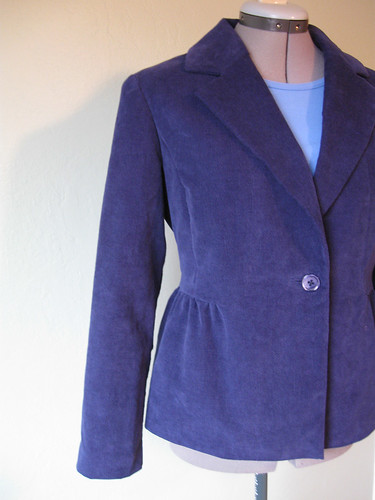
Additional info to all who have commented below on this tool I called a Velvet board, perhaps I should have called it a Needle board. It seems like that is what it is called if you are
searching for notions or sewing supplies.
Recently Rosalind asked me about lining jackets, so coming up I will be making a winter wool coat for myself, and I will post some info about linings then.
Until then, more holiday sewing and garden clean up, in between the raindrops. Plus planting bags of tulips which are easy to buy (colorful packages beckoning) but not so easy to get myself outside to dig and plant.
Happy December sewing to all, Beth

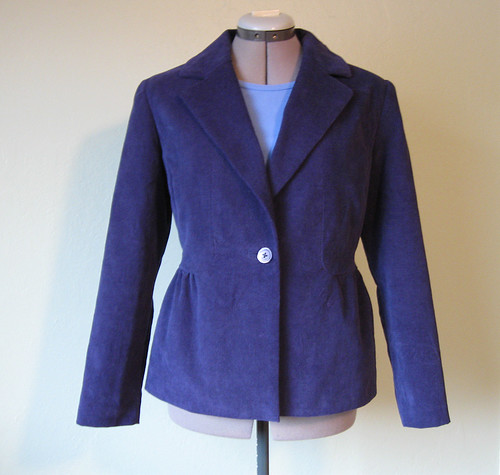

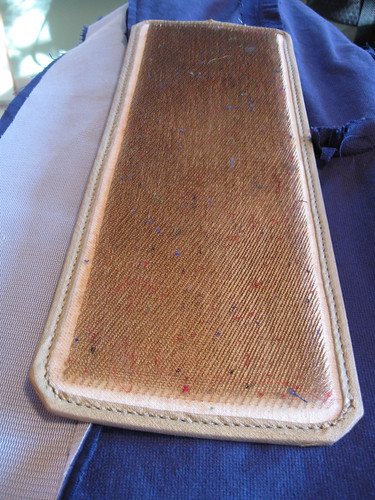
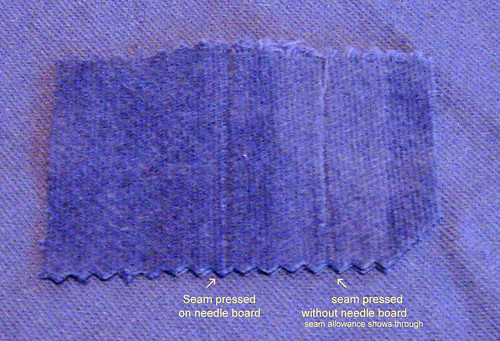
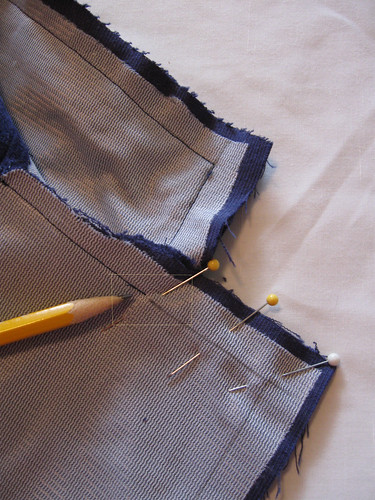
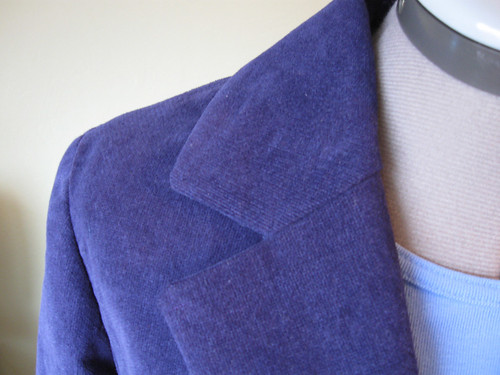

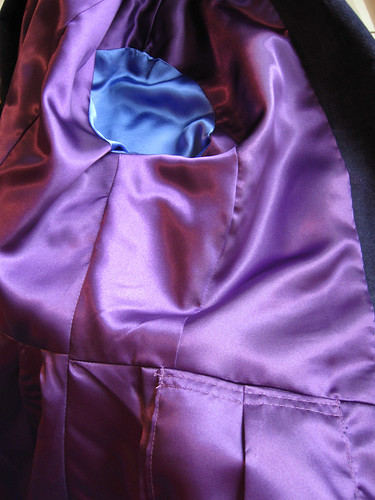










What a lovely jacket , I have always liked cord but I have always been to scared to sew it. I think I will have to purchase a velvet board .
ReplyDeleteOoh, I love this jacket. I've never heard of a velvet board, but must purchase one now. No wonder I always find velvet so hard to sew with!
ReplyDeleteOkay, I just checked online for a velvet board with no luck. Any suggestions as to where to purchase one?
ReplyDeleteHi Amanda, thanks for the nice comment.
ReplyDeleteI just posted a photo of the cardboard sheet that came with mine, brand is Dritz, they call it a Needle board. I think I have seen it at the big chain fabric stores. Be very careful on velvet which I find a lot more difficult than corduroy. link to a Flickr photo http://www.flickr.com/photos/sunnygalstudio/5239067374/
and I can totally see you wearing this jacket ! P.S. I am envious of your lovely custom dress form :)
What a lovely jacket. And thanks for all the tips, including those of turning a collar point on corduroy. Yours turned out perfectly. And I love the two different colors of lining fabric and your hidden inside pocket. Beautiful work
ReplyDeleteGreat jacket. You're so right about wearing it with jeans. Thanks for the info about the velvet board. Never heard of one until just now.
ReplyDeleteI want to reach into my computer and pet this jacket fabric! I've added velveteen to my stash over the years but have never sewn with it. You're made corduroy look luxurious. I especially appreciate your collar tip and pictures which are great illustrations.
ReplyDeleteYour jacket is just beautiful! Thanks for the information on the Needle Board- I now know what to put on my Christmas Wish List!
ReplyDeleteYour jacket is lovely. The collar and lapels are perfect. I had not noticed that pattern before. I put the nap on corduroy in the direction that gives me the color I want. I don't have any in front of me but I seem to recall that the color is usually darker with the nap smooth in the up direction. Thanks for the tip about leaving a gap on the inside corner of the lapel. I will have to try that on a velveteen jacket I plan to make.
ReplyDeleteThis comment has been removed by the author.
ReplyDeleteTerrific jacket and your tutorials are exceptional. I needed a new method for attaching lapels/collars. My tailoring instructor was very old school (from Germany). With today's new interfacing and tools, sewing is much less tedious!! Thanks for sharing!
ReplyDeleteBeth, Your jacket is exquisite. Thank you for the tutorial of the usefulness of the needle board. I've been thinking about purchasing one for a long time. It time I bought one.
ReplyDeleteI want to sew as well as you when I grow up in my sewing abilities....!!!! Simply beautiful work...
ReplyDelete